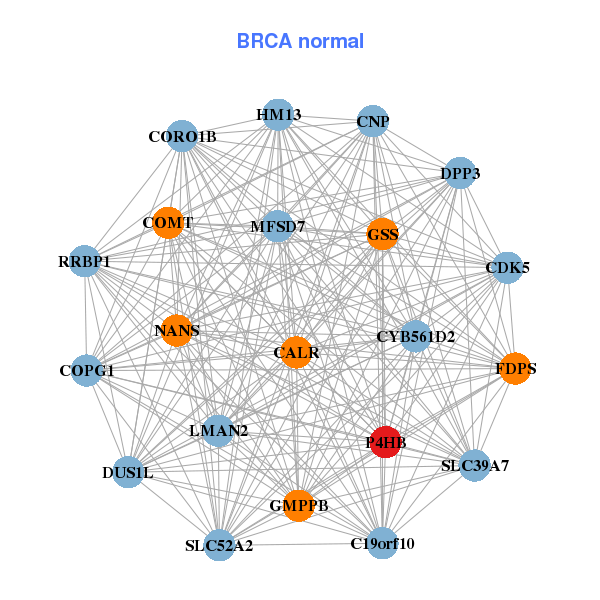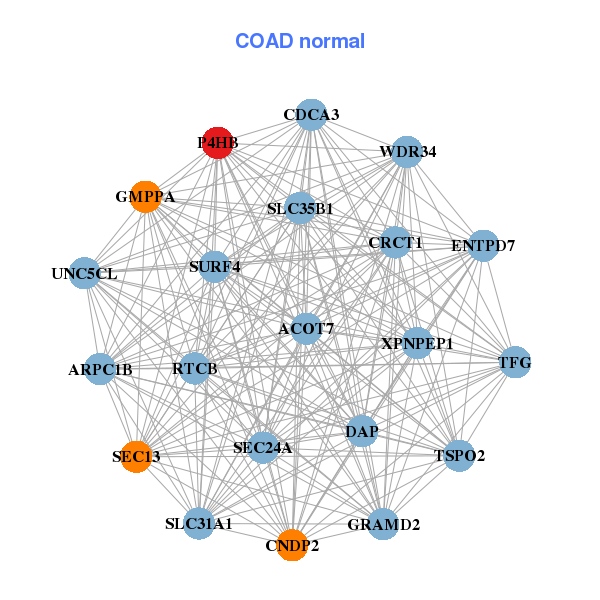|
|||||||||||||||||||||||||||||||||||||||||||||||||||||||||||||||||||||||||||||||||||||||||||||||||||||||||||||||||||||||||||||||||||||||||||||||||||||||||||||||||||||||||||||||||||||||||||||||||||||||||||||||||||||||||||||||||||||||||||||||||||||||||||||||||||||||||||||||||||||||||||||||||||||||||||||||||||||||||||||||||||||||||||||||||||||||||||||||||||||
| |
| Phenotypic Information (metabolism pathway, cancer, disease, phenome) |
| |
| |
| Gene-Gene Network Information: Co-Expression Network, Interacting Genes & KEGG |
| |
|
| Gene Summary for P4HB |
| Basic gene info. | Gene symbol | P4HB |
| Gene name | prolyl 4-hydroxylase, beta polypeptide | |
| Synonyms | DSI|ERBA2L|GIT|P4Hbeta|PDI|PDIA1|PHDB|PO4DB|PO4HB|PROHB | |
| Cytomap | UCSC genome browser: 17q25 | |
| Genomic location | chr17 :79801033-79818544 | |
| Type of gene | protein-coding | |
| RefGenes | NM_000918.3, | |
| Ensembl id | ENSG00000185624 | |
| Description | cellular thyroid hormone-binding proteincollagen prolyl 4-hydroxylase betaglutathione-insulin transhydrogenasep55procollagen-proline, 2-oxoglutarate 4-dioxygenase (proline 4-hydroxylase), beta polypeptideprolyl 4-hydroxylase subunit betaprotein disu | |
| Modification date | 20141207 | |
| dbXrefs | MIM : 176790 | |
| HGNC : HGNC | ||
| Ensembl : ENSG00000185624 | ||
| HPRD : 07181 | ||
| Vega : OTTHUMG00000150269 | ||
| Protein | UniProt: P07237 go to UniProt's Cross Reference DB Table | |
| Expression | CleanEX: HS_P4HB | |
| BioGPS: 5034 | ||
| Gene Expression Atlas: ENSG00000185624 | ||
| The Human Protein Atlas: ENSG00000185624 | ||
| Pathway | NCI Pathway Interaction Database: P4HB | |
| KEGG: P4HB | ||
| REACTOME: P4HB | ||
| ConsensusPathDB | ||
| Pathway Commons: P4HB | ||
| Metabolism | MetaCyc: P4HB | |
| HUMANCyc: P4HB | ||
| Regulation | Ensembl's Regulation: ENSG00000185624 | |
| miRBase: chr17 :79,801,033-79,818,544 | ||
| TargetScan: NM_000918 | ||
| cisRED: ENSG00000185624 | ||
| Context | iHOP: P4HB | |
| cancer metabolism search in PubMed: P4HB | ||
| UCL Cancer Institute: P4HB | ||
| Assigned class in ccmGDB | B - This gene belongs to cancer gene. | |
| Top |
| Phenotypic Information for P4HB(metabolism pathway, cancer, disease, phenome) |
| Cancer | CGAP: P4HB |
| Familial Cancer Database: P4HB | |
| * This gene is included in those cancer gene databases. |
|
|
|
|
|
|
| |||||||||||||||||||||||||||||||||||||||||||||||||||||||||||||||||||||||||||||||||||||||||||||||||||||||||||||||||||||||||||||||||||||||||||||||||||||||||||||||||||||||||||||||||||||||||||||||||||||||||||||||||||||||||||||||||||||||||||||||||||||||||||||||||||||||||||||||||||||||||||||||||||||||||||||||||||||||||||||||||||||||||||||||||||||||||||||||
Oncogene 1 | Significant driver gene in | ||||||||||||||||||||||||||||||||||||||||||||||||||||||||||||||||||||||||||||||||||||||||||||||||||||||||||||||||||||||||||||||||||||||||||||||||||||||||||||||||||||||||||||||||||||||||||||||||||||||||||||||||||||||||||||||||||||||||||||||||||||||||||||||||||||||||||||||||||||||||||||||||||||||||||||||||||||||||||||||||||||||||||||||||||||||||||||||||||||
| cf) number; DB name 1 Oncogene; http://nar.oxfordjournals.org/content/35/suppl_1/D721.long, 2 Tumor Suppressor gene; https://bioinfo.uth.edu/TSGene/, 3 Cancer Gene Census; http://www.nature.com/nrc/journal/v4/n3/abs/nrc1299.html, 4 CancerGenes; http://nar.oxfordjournals.org/content/35/suppl_1/D721.long, 5 Network of Cancer Gene; http://ncg.kcl.ac.uk/index.php, 1Therapeutic Vulnerabilities in Cancer; http://cbio.mskcc.org/cancergenomics/statius/ |
| REACTOME_METABOLISM_OF_LIPIDS_AND_LIPOPROTEINS REACTOME_LIPOPROTEIN_METABOLISM | |
| OMIM | 176790; gene. |
| Orphanet | |
| Disease | KEGG Disease: P4HB |
| MedGen: P4HB (Human Medical Genetics with Condition) | |
| ClinVar: P4HB | |
| Phenotype | MGI: P4HB (International Mouse Phenotyping Consortium) |
| PhenomicDB: P4HB | |
| Mutations for P4HB |
| * Under tables are showing count per each tissue to give us broad intuition about tissue specific mutation patterns.You can go to the detailed page for each mutation database's web site. |
| - Statistics for Tissue and Mutation type | Top |
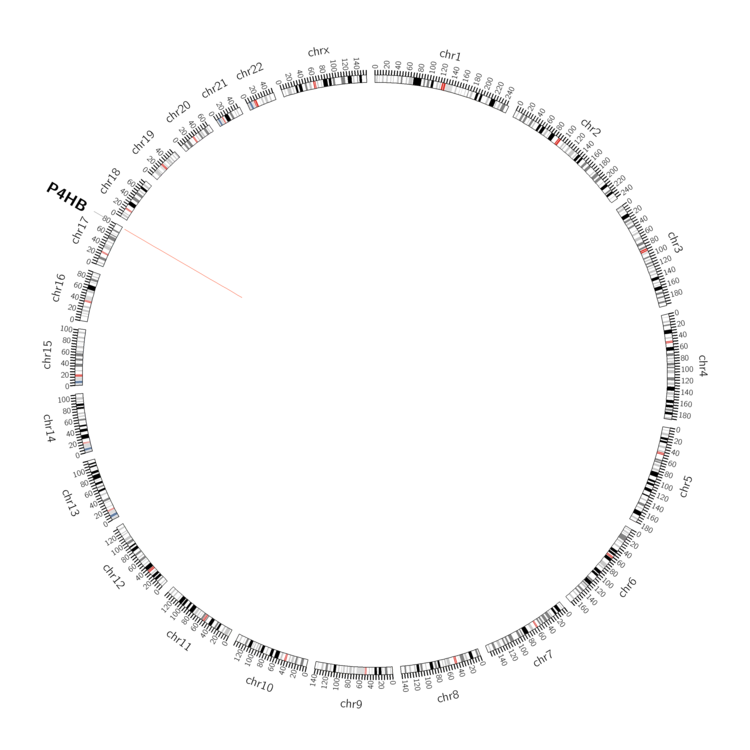 |
| - For Inter-chromosomal Variations |
| There's no inter-chromosomal structural variation. |
| - For Intra-chromosomal Variations |
| * Intra-chromosomal variantions includes 'intrachromosomal amplicon to amplicon', 'intrachromosomal amplicon to non-amplified dna', 'intrachromosomal deletion', 'intrachromosomal fold-back inversion', 'intrachromosomal inversion', 'intrachromosomal tandem duplication', 'Intrachromosomal unknown type', 'intrachromosomal with inverted orientation', 'intrachromosomal with non-inverted orientation'. |
 |
| Sample | Symbol_a | Chr_a | Start_a | End_a | Symbol_b | Chr_b | Start_b | End_b |
| ovary | P4HB | chr17 | 79807097 | 79807117 | chr17 | 79798818 | 79798838 |
| cf) Tissue number; Tissue name (1;Breast, 2;Central_nervous_system, 3;Haematopoietic_and_lymphoid_tissue, 4;Large_intestine, 5;Liver, 6;Lung, 7;Ovary, 8;Pancreas, 9;Prostate, 10;Skin, 11;Soft_tissue, 12;Upper_aerodigestive_tract) |
| * From mRNA Sanger sequences, Chitars2.0 arranged chimeric transcripts. This table shows P4HB related fusion information. |
| ID | Head Gene | Tail Gene | Accession | Gene_a | qStart_a | qEnd_a | Chromosome_a | tStart_a | tEnd_a | Gene_a | qStart_a | qEnd_a | Chromosome_a | tStart_a | tEnd_a |
| AW410007 | RPS9 | 24 | 65 | 19 | 54704742 | 54705054 | P4HB | 66 | 545 | 17 | 79803074 | 79804852 | |
| DC413827 | P4HB | 2 | 295 | 17 | 79817205 | 79818437 | PLEKHB2 | 291 | 519 | 2 | 131905344 | 131905573 | |
| BE878135 | HELZ | 1 | 228 | 17 | 65069444 | 65069671 | P4HB | 221 | 335 | 17 | 79801037 | 79801151 | |
| CN345438 | P4HB | 9 | 411 | 17 | 79817057 | 79818398 | MAP4K4 | 410 | 622 | 2 | 102459069 | 102460700 | |
| BP290873 | P4HB | 1 | 209 | 17 | 79801408 | 79801616 | UBE2E3 | 209 | 361 | 2 | 181846811 | 181846963 | |
| Top |
| Mutation type/ Tissue ID | brca | cns | cerv | endome | haematopo | kidn | Lintest | liver | lung | ns | ovary | pancre | prost | skin | stoma | thyro | urina | |||
| Total # sample | 1 | 1 | ||||||||||||||||||
| GAIN (# sample) | 1 | |||||||||||||||||||
| LOSS (# sample) | 1 |
| cf) Tissue ID; Tissue type (1; Breast, 2; Central_nervous_system, 3; Cervix, 4; Endometrium, 5; Haematopoietic_and_lymphoid_tissue, 6; Kidney, 7; Large_intestine, 8; Liver, 9; Lung, 10; NS, 11; Ovary, 12; Pancreas, 13; Prostate, 14; Skin, 15; Stomach, 16; Thyroid, 17; Urinary_tract) |
| Top |
|
 |
| Top |
| Stat. for Non-Synonymous SNVs (# total SNVs=29) | (# total SNVs=22) |
 | 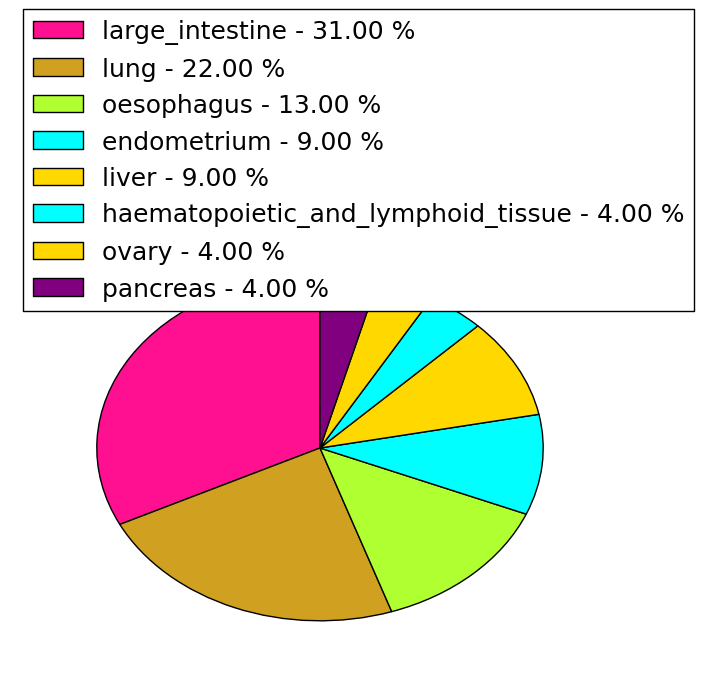 |
(# total SNVs=2) | (# total SNVs=0) |
 |
| Top |
| * When you move the cursor on each content, you can see more deailed mutation information on the Tooltip. Those are primary_site,primary_histology,mutation(aa),pubmedID. |
| GRCh37 position | Mutation(aa) | Unique sampleID count |
| chr17:79818260-79818260 | p.R30R | 6 |
| chr17:79803083-79803083 | p.R461R | 3 |
| chr17:79817119-79817119 | p.R97H | 2 |
| chr17:79804462-79804462 | p.R300H | 2 |
| chr17:79813041-79813041 | p.D201H | 2 |
| chr17:79803437-79803437 | p.T453T | 2 |
| chr17:79803764-79803764 | p.N387fs*118 | 2 |
| chr17:79804413-79804413 | p.R316R | 1 |
| chr17:79817103-79817103 | p.I102I | 1 |
| chr17:79801949-79801949 | p.E489A | 1 |
| Top |
|
 |
| Point Mutation/ Tissue ID | 1 | 2 | 3 | 4 | 5 | 6 | 7 | 8 | 9 | 10 | 11 | 12 | 13 | 14 | 15 | 16 | 17 | 18 | 19 | 20 |
| # sample | 6 | 1 | 3 | 1 | 2 | 6 | 4 | 4 | 6 | 1 | 7 | |||||||||
| # mutation | 7 | 1 | 3 | 1 | 2 | 6 | 5 | 4 | 7 | 1 | 7 | |||||||||
| nonsynonymous SNV | 4 | 1 | 3 | 1 | 1 | 4 | 4 | 3 | 4 | 5 | ||||||||||
| synonymous SNV | 3 | 1 | 2 | 1 | 1 | 3 | 1 | 2 |
| cf) Tissue ID; Tissue type (1; BLCA[Bladder Urothelial Carcinoma], 2; BRCA[Breast invasive carcinoma], 3; CESC[Cervical squamous cell carcinoma and endocervical adenocarcinoma], 4; COAD[Colon adenocarcinoma], 5; GBM[Glioblastoma multiforme], 6; Glioma Low Grade, 7; HNSC[Head and Neck squamous cell carcinoma], 8; KICH[Kidney Chromophobe], 9; KIRC[Kidney renal clear cell carcinoma], 10; KIRP[Kidney renal papillary cell carcinoma], 11; LAML[Acute Myeloid Leukemia], 12; LUAD[Lung adenocarcinoma], 13; LUSC[Lung squamous cell carcinoma], 14; OV[Ovarian serous cystadenocarcinoma ], 15; PAAD[Pancreatic adenocarcinoma], 16; PRAD[Prostate adenocarcinoma], 17; SKCM[Skin Cutaneous Melanoma], 18:STAD[Stomach adenocarcinoma], 19:THCA[Thyroid carcinoma], 20:UCEC[Uterine Corpus Endometrial Carcinoma]) |
| Top |
| * We represented just top 10 SNVs. When you move the cursor on each content, you can see more deailed mutation information on the Tooltip. Those are primary_site, primary_histology, mutation(aa), pubmedID. |
| Genomic Position | Mutation(aa) | Unique sampleID count |
| chr17:79804359 | p.L334L | 2 |
| chr17:79813047 | p.D199H | 2 |
| chr17:79813082 | p.S168F | 1 |
| chr17:79801949 | p.E485Q | 1 |
| chr17:79803440 | p.T335T | 1 |
| chr17:79804462 | p.P135P | 1 |
| chr17:79813104 | p.D480V | 1 |
| chr17:79801953 | p.T325T | 1 |
| chr17:79803467 | p.R132H | 1 |
| chr17:79804502 | p.G473S | 1 |
| * Copy number data were extracted from TCGA using R package TCGA-Assembler. The URLs of all public data files on TCGA DCC data server were gathered on Jan-05-2015. Function ProcessCNAData in TCGA-Assembler package was used to obtain gene-level copy number value which is calculated as the average copy number of the genomic region of a gene. |
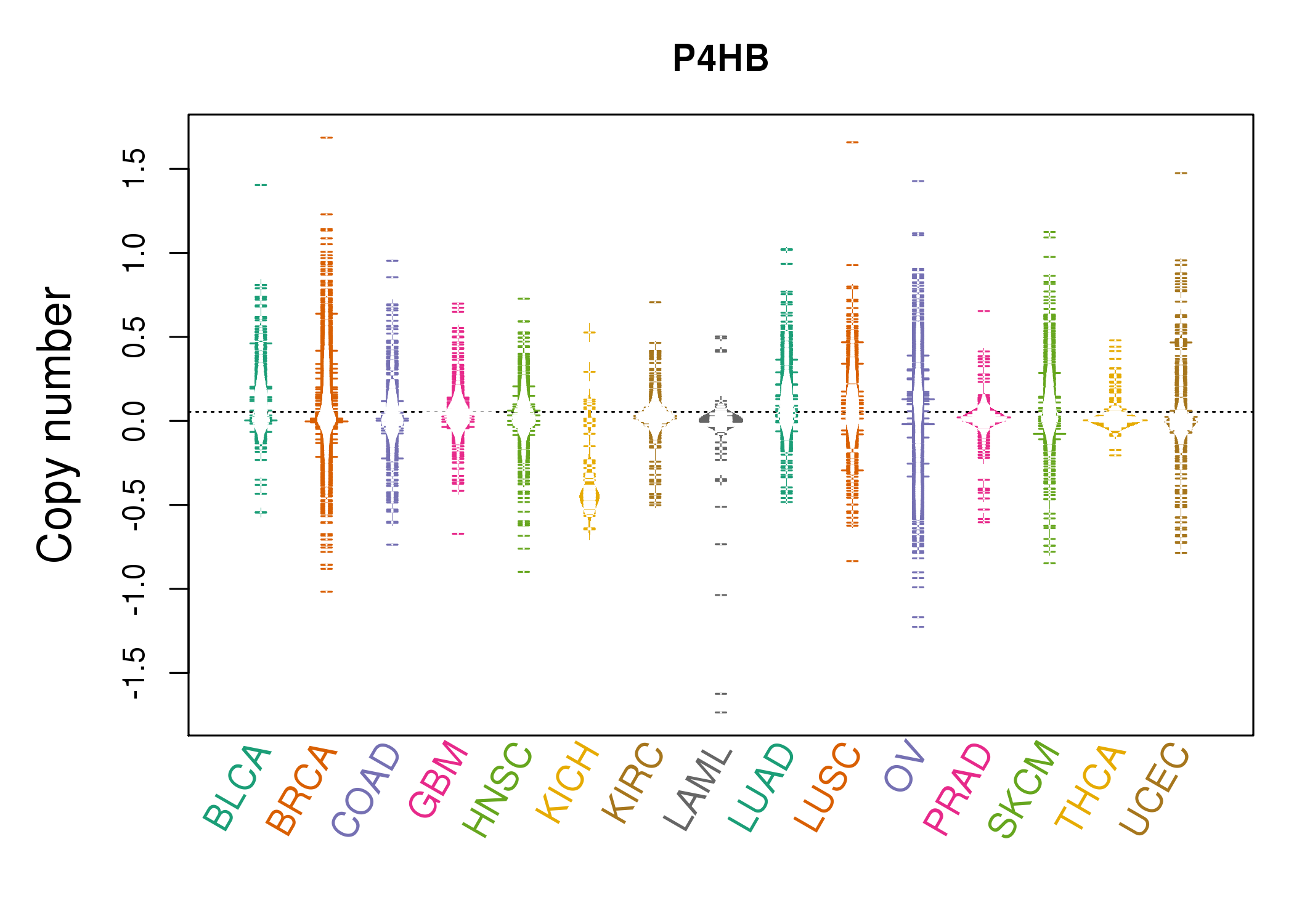 |
| cf) Tissue ID[Tissue type]: BLCA[Bladder Urothelial Carcinoma], BRCA[Breast invasive carcinoma], CESC[Cervical squamous cell carcinoma and endocervical adenocarcinoma], COAD[Colon adenocarcinoma], GBM[Glioblastoma multiforme], Glioma Low Grade, HNSC[Head and Neck squamous cell carcinoma], KICH[Kidney Chromophobe], KIRC[Kidney renal clear cell carcinoma], KIRP[Kidney renal papillary cell carcinoma], LAML[Acute Myeloid Leukemia], LUAD[Lung adenocarcinoma], LUSC[Lung squamous cell carcinoma], OV[Ovarian serous cystadenocarcinoma ], PAAD[Pancreatic adenocarcinoma], PRAD[Prostate adenocarcinoma], SKCM[Skin Cutaneous Melanoma], STAD[Stomach adenocarcinoma], THCA[Thyroid carcinoma], UCEC[Uterine Corpus Endometrial Carcinoma] |
| Top |
| Gene Expression for P4HB |
| * CCLE gene expression data were extracted from CCLE_Expression_Entrez_2012-10-18.res: Gene-centric RMA-normalized mRNA expression data. |
 |
| * Normalized gene expression data of RNASeqV2 was extracted from TCGA using R package TCGA-Assembler. The URLs of all public data files on TCGA DCC data server were gathered at Jan-05-2015. Only eight cancer types have enough normal control samples for differential expression analysis. (t test, adjusted p<0.05 (using Benjamini-Hochberg FDR)) |
 |
| Top |
| * This plots show the correlation between CNV and gene expression. |
: Open all plots for all cancer types
 |
|
 |
|
| Top |
| Gene-Gene Network Information |
| * Co-Expression network figures were drawn using R package igraph. Only the top 20 genes with the highest correlations were shown. Red circle: input gene, orange circle: cell metabolism gene, sky circle: other gene |
: Open all plots for all cancer types
 |
| ||||
| ANAPC11,ARHGDIA,OGFOD3,C17orf89,PRADC1,CALR,CCDC137, DUS1L,GAA,GPS1,MRPL12,P4HB,PCYT2,PPIB, PYCR1,SEC61A1,SLC25A10,SLC38A10,STRA13,ALYREF,TMEM104 | C19orf10,CALR,CDK5,CNP,COMT,COPG1,CORO1B, CYB561D2,DPP3,DUS1L,FDPS,GMPPB,SLC52A2,GSS, HM13,LMAN2,MFSD7,NANS,P4HB,RRBP1,SLC39A7 | ||||
 |
| ||||
| AGR2,OGFOD3,C19orf10,CALR,CRELD2,ERO1L,GMPPA, HSP90B1,HSPA5,LGALS3BP,MANF,NUCB2,P4HB,PDIA3, PDIA3P1,PDIA4,PKM,PPIB,SEC61A1,SLC16A3,SRP68 | ACOT7,ARPC1B,RTCB,CDCA3,CNDP2,CRCT1,DAP, ENTPD7,GMPPA,GRAMD2,P4HB,SEC13,SEC24A,SLC31A1, SLC35B1,SURF4,TFG,TSPO2,UNC5CL,WDR34,XPNPEP1 |
| * Co-Expression network figures were drawn using R package igraph. Only the top 20 genes with the highest correlations were shown. Red circle: input gene, orange circle: cell metabolism gene, sky circle: other gene |
: Open all plots for all cancer types
| Top |
: Open all interacting genes' information including KEGG pathway for all interacting genes from DAVID
| Top |
| Pharmacological Information for P4HB |
| DB Category | DB Name | DB's ID and Url link |
| Chemistry | BindingDB | P07237; -. |
| Chemistry | ChEMBL | CHEMBL2364681; -. |
| Organism-specific databases | PharmGKB | PA32876; -. |
| Organism-specific databases | CTD | 5034; -. |
| * Gene Centered Interaction Network. |
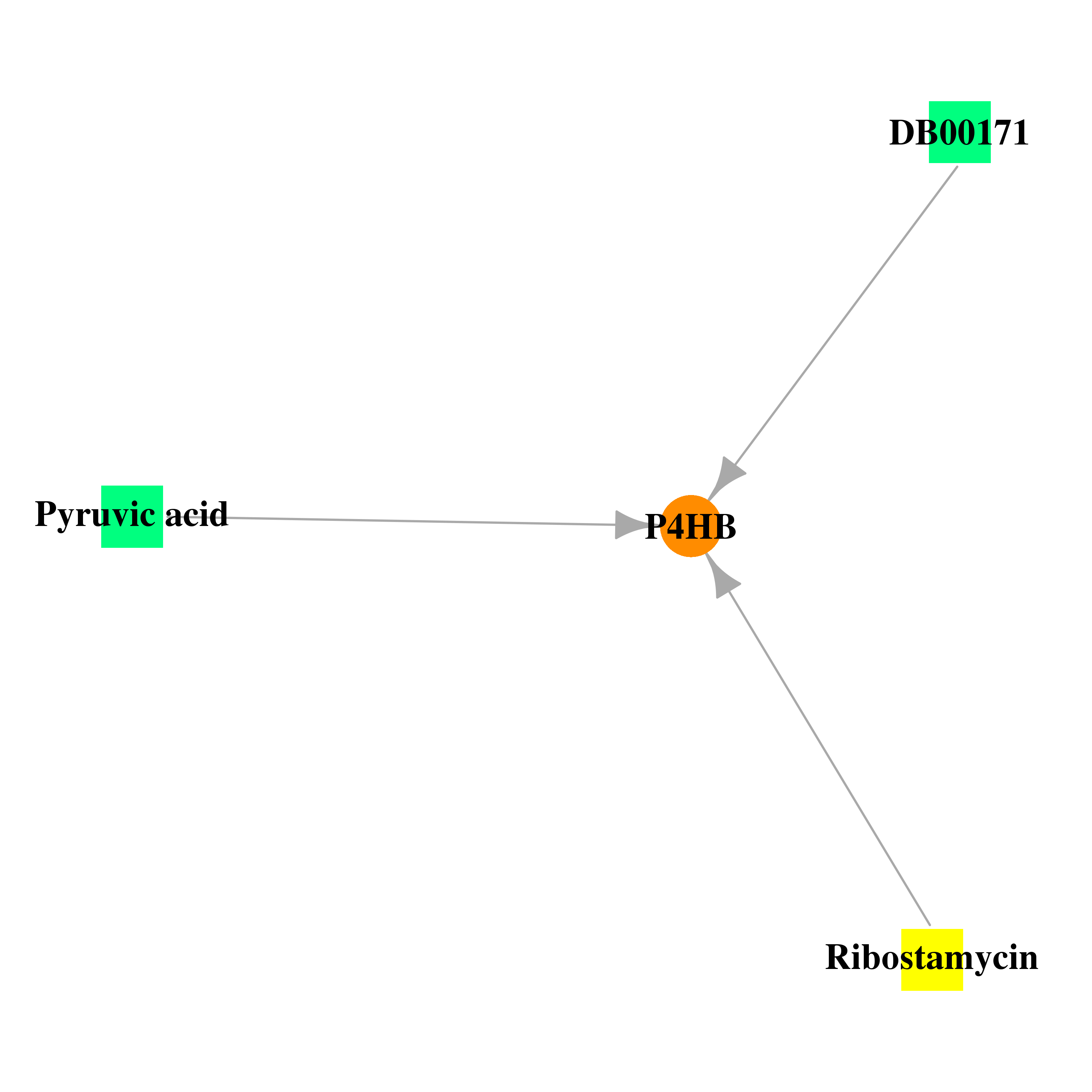 |
| * Drug Centered Interaction Network. |
| DrugBank ID | Target Name | Drug Groups | Generic Name | Drug Centered Network | Drug Structure |
| DB03615 | prolyl 4-hydroxylase, beta polypeptide | experimental | Ribostamycin | 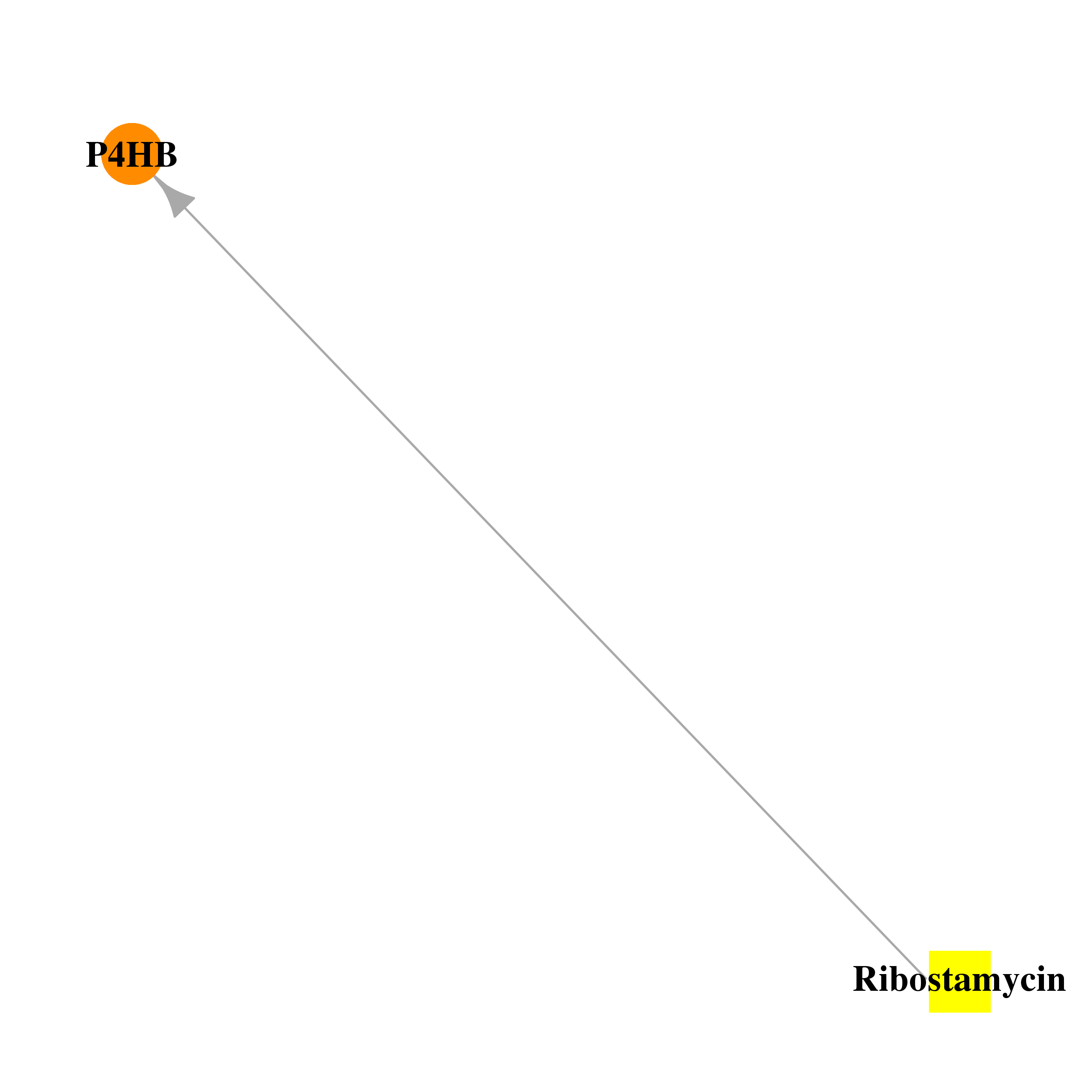 | 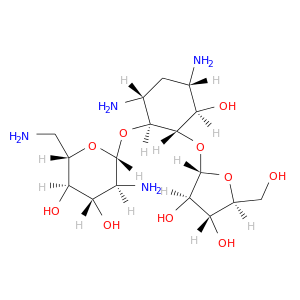 |
| DB00171 | prolyl 4-hydroxylase, beta polypeptide | approved; nutraceutical | Adenosine triphosphate |  |  |
| DB00119 | prolyl 4-hydroxylase, beta polypeptide | approved; nutraceutical | Pyruvic acid | 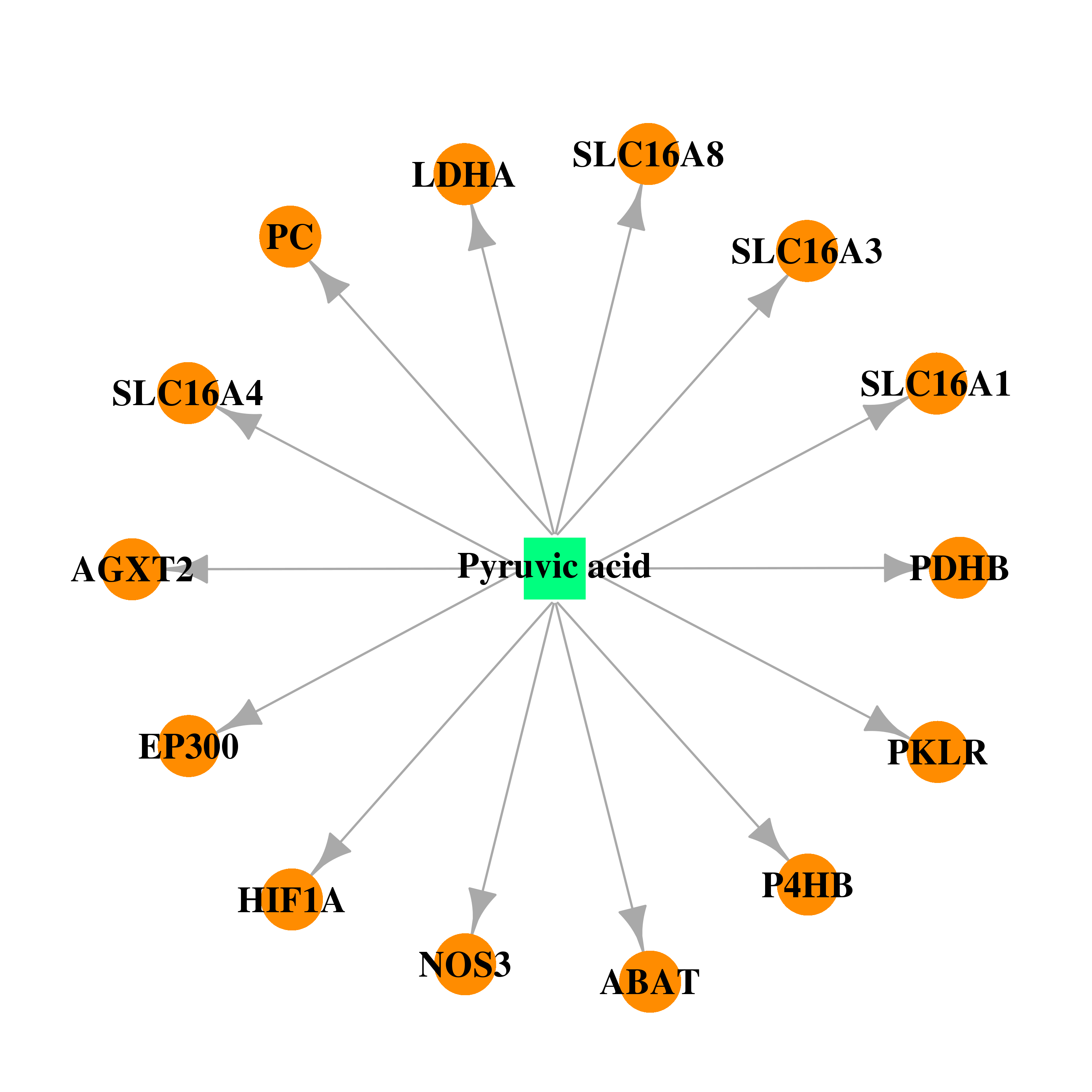 | 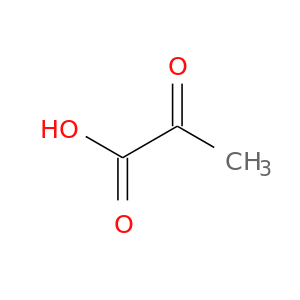 |
| Top |
| Cross referenced IDs for P4HB |
| * We obtained these cross-references from Uniprot database. It covers 150 different DBs, 18 categories. http://www.uniprot.org/help/cross_references_section |
: Open all cross reference information
|
Copyright © 2016-Present - The Univsersity of Texas Health Science Center at Houston @ |








